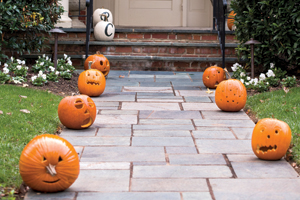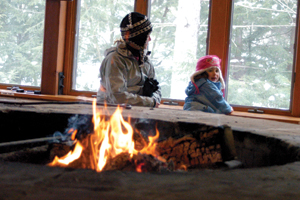Ask an Expert: Fall 2017
What can you do with your pumpkins after Halloween is over? What should you know about selecting firewood? Our experts break it down in our fall magazine!

Pumpkin-lined walkway; by Albert Herring
What can I do with my pumpkins after Halloween is over? (Annie in Oakland)
While pumpkin-flavored everything crowds the shelves at coffee shops and supermarkets, many of us are also buying whole pumpkins to carve and decorate. Interestingly enough, pumpkins are native to North America and can be a great food source for humans as well as wildlife. Here are some ideas to recycle your festive orange gourds:
Carve and compost. After carving a pumpkin, compost the innards. The material is mostly water and will break down quickly. Once you are done with the pumpkin, you can compost that as well!
Serve and/or sow the seeds. If you don’t eat pumpkin seeds, wildlife will. Allow seeds to air dry (do not salt or season), and lay them outside where critters can get them.
Alternatively, you can take some of your collected seeds and plant them for next year’s patch. They can be sown directly in the ground following the last spring frost. Leave at least 20 feet for each plant. If you want large pumpkins by next Halloween, start them off indoors before transplanting.
Tiny, native squash bees that live in the ground pollinate pumpkin flowers, so be sure you don’t destroy their nests by over-tilling the soil.
Create a snack-o-lantern. For this all-natural bird feeder, you’ll need two dowels and four evenly cut pieces of rope. Remove the top of the pumpkin, poke one dowel across the width of the pumpkin, and the other about midway down in the opposite direction. Tie a strand of rope to each of the pegs sticking out, and tie them all together in a large knot.
Poke several small holes in the bottom as well to allow rainwater to get out. Fill with birdseed, hang it in your yard and watch as hungry birds come to eat!
Serve sections of pumpkins. If you have leftover pumpkin, cut it up and lay it out specifically for wildlife. Chipmunks, groundhogs, squirrels and even late-season butterflies will all feed off of it.
—Kerry Wixted, Wildlife Education Specialist

New Germany Lake House; by Stephen Badger
What should I know about selecting firewood? (Will in Bel Air)
Many people prefer to heat their homes with wood, and for good reason. Wood gives a rich, dry heat that seems to warm you from the inside out. Many also prefer the dancing flame of the fire itself to that of a gas or oil burner. Plus, modern wood stoves reduce pollution.
Choosing wood is easy. Oak has more heat content than maple, but the main consideration is dryness. It takes about 12 months to fully season firewood—that is, for it to air-dry enough to allow it to burn efficiently. Green wood—that which isn’t yet sufficiently dry—burns poorly. It gives off more smoke and less heat, plugs up your chimney and ultimately wastes your money. Species matters less than dryness, so whatever wood you use, make sure it’s been split in half, if not quarters, for at least nine months before burning.
For those who cut their own wood, remember that we have a serious invasive pest in our woods: the emerald ash borer. Though treatment efforts are underway, this devastating beetle has no predators and is ravaging our ash trees. And it’s not the only bad bug out there. The ambrosia beetle, black walnut twig beetle and gypsy moth may all hitch rides in the backs of trucks loaded with firewood. For this reason, Maryland’s state parks don’t allow you to enter with your own wood. Also bear in mind that snakes and other wildlife may seek cover in woodpiles kept outside.
One of the greatest hallmarks of firewood is it’s natural. Odds are that it grew within 15 miles of your home, so it’s the ultimate “buy local” example. The economics of burning wood is still a good deal as well, even with the recent decline of fossil fuel prices. Pound for pound, or rather, dollar for dollar, wood is about as cheap as oil, and let’s be honest: wood is just plain prettier. And more fun. And satisfying.
About 23,000 Maryland households use wood as their primary heat source; most users rely on it as a secondary source. If you are thinking of switching to wood, the Maryland Energy Administration offers grants to help you get started.
—Dan Rider, Forest Stewardship Manager
Send YOUR questions for our experts to news.dnr@maryland.gov!


 1-888-373-7888
1-888-373-7888 233733
233733